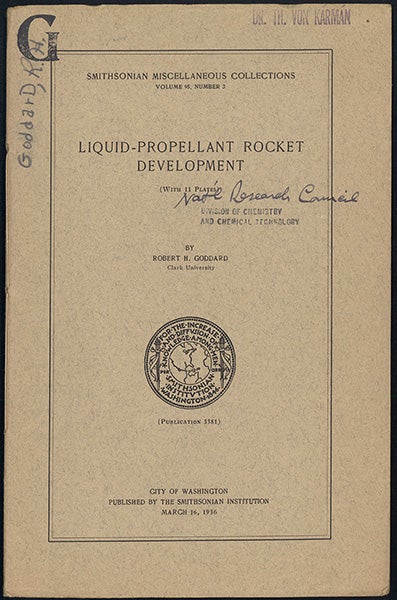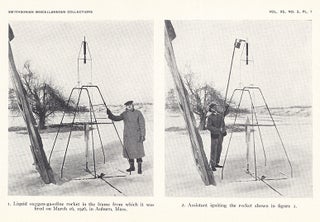Liquid-propellant rocket development.
Publisher Information: Washington DC: Smithsonian, 1936.
Goddard, Robert H. (1882-1945). Liquid-propellant rocket development. 10pp. 6 plate leaves. Washington, DC: Smithsonian Institution, 1936. 246 x 163 mm. Original printed wrappers; preserved in a cloth drop-back box. Fine copy. From the library of aviation and aerospace pioneer Theodore von Kármán (1881-1963), with his stamp and docketing on the front wrapper. Front wrapper inscribed “Nat’l Research Council,” with stamp beneath reading “Division of Chemistry and Chemical Technology.”
First Edition. “Like the Russian hero Konstantin Tsiolkovsky and the German pioneer Hermann Oberth, Goddard worked out the theory of rocket propulsion independently . . . Having explored the mathematical practicality of rocketry since 1906 and the experimental workability of reaction engines in laboratory vacuum tests since 1912, Goddard began to accumulate ideas for probing beyond the Earth’s stratosphere. His first two patents in 1914, for a liquid-fuel gun rocket and a multistage step rocket, let to some modest recognition and financial support from the Smithsonian Institution . . . With an eye toward patentability of demonstrated systems and with the aid of no more than a handful of technicians, Goddard achieved a series of workable liquid-fuel flights starting in 1926. Through the patronage of Charles A. Lindbergh, the Daniel and Florence Guggenheim Foundation, and the Carnegie and Smithsonian institutions, the Goddards and their small staff were able to move near Roswell, New Mexico. There, during most of the 1930s, Goddard demonstrated, despite many failures in his systematic static and flight tests, progressively more sophisticated experimental boosters and payloads, reaching speeds of 700 miles per hour and altitudes above 8000 feet in several test flights” (Dictionary of Scientific Biography). The secretive Goddard published only two papers on rocketry, “A Method of Reaching Extreme Altitudes” (1919) and the present work. The remainder of his work was documented in patents.
This copy is from the library of aeronautics pioneer Theodore von Kármán, who in addition to directing the Jet Propulsion Laboratory at Caltech was also the founder of the Aerojet Engineering Corporation, one of the industrial giants of the jet age. “At Caltech, Karman and his students laid the foundations for aerodynamic design leading to supersonic flight” (Dictionary of Scientific Biography).
Book Id: 43705Price: $3,000.00


